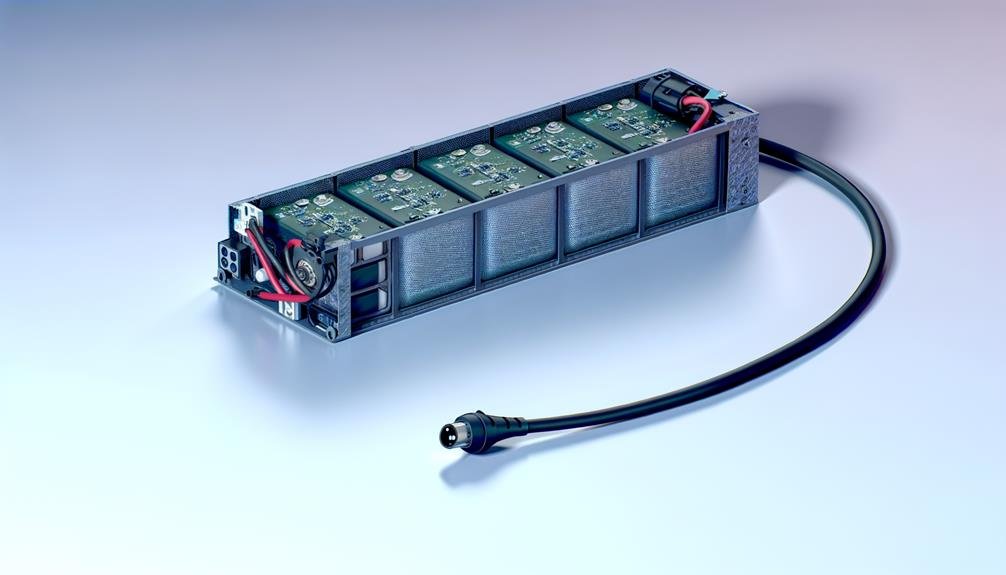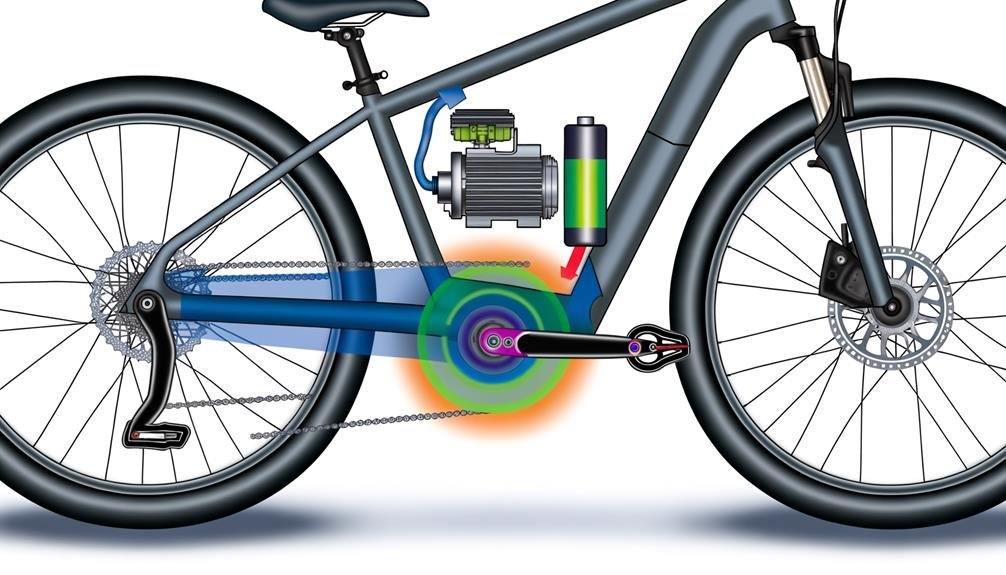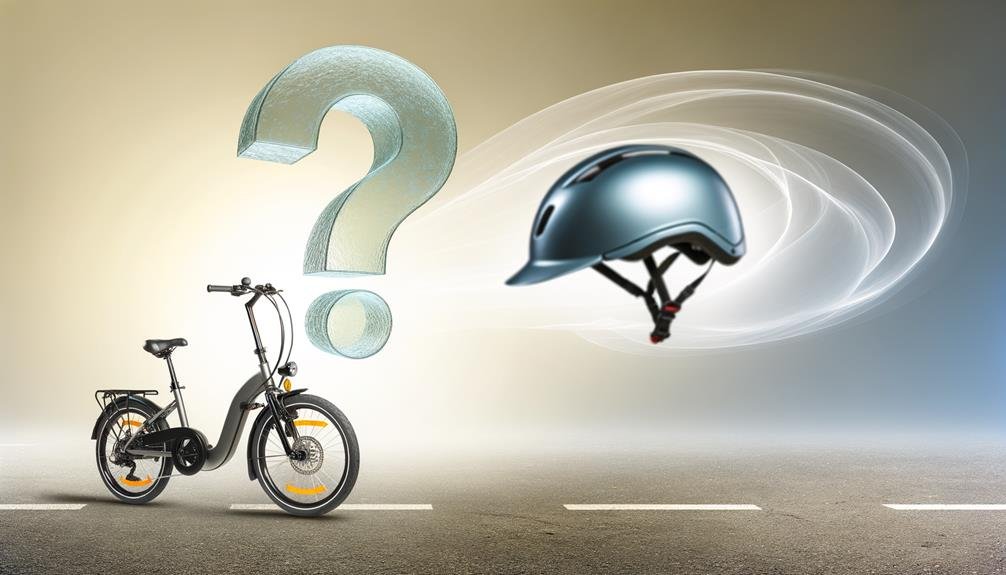Charles Miller is a veteran bike enthusiast with over 12 years of experience dealing with bikes as a mechanic. Despite immense love and expertise for...
Did you know that electric bikes, or e-bikes, use a clever blend of human and mechanical power to get you from place to place? They're not just about being lazy and letting the bike do all the work – far from it.
In reality, e-bikes offer a unique system that combines the effort from your pedaling with the boost from a small motor powered by a rechargeable battery. This synergy makes the ride smoother, less tiring, and more enjoyable, especially on inclines or long distances.
But how does this all come together, and what's the secret behind this efficient form of transport? Stay with me, and I'll unravel the fascinating mechanics behind e-bikes.
Key Takeaways
- Electric bikes use a combination of human and mechanical power, with a motor powered by a rechargeable battery.
- The battery plays a crucial role in powering the motor, control unit, display, and sensors, and determines the bike's range.
- The motor provides assistance while pedaling, drawing energy from the battery to make uphill rides or long distances easier.
- Pedal assist allows riders to control the amount of extra power while pedaling, making biking more enjoyable and enabling them to tackle hills or headwinds without exerting excessive effort.
Understanding Electric Bikes
Let's dive right into understanding electric bikes, which are equipped with a motor, battery, and a unique method of delivering electricity, usually via a display on the handlebar. E-bikes are more than just a trendy gadget; they're a community, a lifestyle, and a revolution in personal transportation.
The heart of electric bikes, or ebikes, is the motor. Typically, it's a brushless rear hub or a mid-drive motor that provides power directly to the back wheel. This ebike motor will provide varying levels of assistance depending on your needs, making uphill rides or long commutes a breeze.
Next comes the battery. The battery capacity will determine the range of your electric bike, the higher the capacity, the farther you can ride. These batteries are usually rechargeable lithium-ion, perfect for many joyrides to come.
But how do electric bikes work exactly? It's all in the pedal assist. This system allows you to control the electricity delivery to the motor. It's like having a personal cheerleader, pushing you along when you need that extra boost.
Components of an E-Bike
Diving into the heart of an e-bike, it's crucial to understand its main components: the motor, the battery, and the handlebar-mounted display that delivers electricity.
As a part of this community, you'll appreciate knowing more about how electric bikes work.
First, we've the motor, typically a 250-watt brushless rear hub motor located on the back wheel. This is the powerhouse of the e-bike, the heart that propels it forward.
The power is all about the battery, usually a rechargeable lithium-ion one. It's the juice that keeps the motor running and determines the bike's range.
The electricity is delivered through a display mounted on the handlebar. This clever little device allows us, the riders, to control assistance levels and keep an eye on the battery level. It's like the brain of the bike, keeping us informed and in control.
The Role of the Battery

Powering the motor, control unit, display, and sensors, the rechargeable lithium-ion battery of an e-bike serves an integral role, with its capacity determining how far you can travel. Replacing the once bulky lead-acid batteries, the lithium-ion battery provides the punch of power the motor needs, while also supplying the juice for the control unit, display, and sensors.
Without a battery, e-bikes work no better than a regular bike. Whether it's located on the down tube or above the rear tire, the heart of an e-bike provides the needed motor power. The role of the battery doesn't stop there – it's also the source of data tracking and support mode selection.
| Function | Power Source | Battery Location |
|---|---|---|
| Motor | Comes from the battery | Down tube / Above rear tire |
| Control unit, display, and sensors | Comes from the battery | Down tube / Above rear tire |
| Support modes and riding data tracking | Comes from the battery | Down tube / Above rear tire |
Just remember, to keep the e-bike experience smooth and hassle-free, the battery does need to be charged. You're part of a community that values the ease and efficiency of e-bikes, and understanding the role of the battery brings us all closer.
Motor Functionality Explained
Having understood the integral role of the battery in an e-bike, we can now explore the functionality of the motor and how it enhances the biking experience. The motor in an e-bike isn't just an added feature, but a key element that significantly changes how we ride. This is where 'motor functionality explained' comes in.
The type of motor used in an e-bike can differ, with mid-drive motors being one common option. These are located near the pedals and generate power that directly drives the crankshaft. This creates a seamless biking experience because the motor uses your pedal power to propel the bike, just like a traditional bicycle, but with an added boost!
Now, you may ask, 'how do electric bikes work with the motor and battery together?' Well, the motor draws energy from the battery to provide assistance when you're pedaling. This means you're still getting a workout, but with reduced effort. As you pedal, the motor works to share the load. This is particularly helpful when tackling steep inclines or long distances.
Pedal Assist and How It Works

Now, let's shift gears and talk about pedal assist, a clever feature that allows you to control the amount of extra power you need while pedaling, enhancing your effort without completely taking over.
This remarkable feature utilizes a sensor installed in the bottom bracket of your bike, which is connected to the mid-drive motors or hub motor. Every time you pedal, the sensor sends a signal to the motor, telling it how much assistance to provide.
As you ride, you can select your preferred level of assistance from a display mounted on the handlebars. This could range from a subtle push, like a gentle tailwind, to a forceful shove, similar to having a powerful cyclist helping you out. The assistance level can be adjusted on a scale from 1 to 52, giving you complete control over your ride.
Pedal assist doesn't just make pedaling easier, it revolutionizes the entire biking experience. Imagine tackling those steep hills or fighting against a fierce headwind without breaking a sweat. That's what pedal assist brings to the table.
It's all about making your ride more enjoyable, enabling you to go further, and making every pedal count.
Maintenance and Care of E-Bikes
Just like any other vehicle, your e-bike requires regular maintenance and care to keep it running smoothly and efficiently. This is especially true if you've invested in one of the best electric road bikes. The maintenance and care of e-bikes doesn't have to be daunting, though. In fact, it's quite similar to maintaining a regular bike.
Here are a few things you should do regularly:
- Check your tire pressure and inflate if necessary. Riding on under-inflated tires can be dangerous and can cause your mid-drive motors to work harder than necessary.
- Keep your chain clean and well-lubricated. This reduces wear and tear and ensures smooth operation.
- Inspect your brake pads and cables. If they're worn out, your braking effectiveness will be reduced and your motor will no longer be able to stop you safely.
If you ride an e-bike to and from work or as your main mode of public transport, you'll want to check your front wheel and top tube for any signs of damage. Regular maintenance and care will ensure your e-bike lasts longer and performs better. After all, an ounce of prevention is worth a pound of cure.
Frequently Asked Questions
Do You Still Have to Pedal an Electric Bike?
Absolutely, you still have to pedal an electric bike. It's like a regular bike but with extra oomph! The motor kicks in when you pedal, giving you a boost and making the ride easier.
Do Electric Bikes Charge Themselves While Pedaling?
No, electric bikes don't charge themselves while pedaling. They're designed to assist, not generate power. You've got to charge the battery externally. Pedaling simply tells the motor how much help to give you.
How Does the Electric Bike Work?
I'm pedaling my electric bike, and it's like I've got superpowers! The motor kicks in, powered by a rechargeable battery. I control how much extra boost I get through a handlebar-mounted display. It's amazing!
What's the Difference Between an E-Bike and an Electric Bike?
Well, here's a fun fact: there's no difference! An e-bike and an electric bike are the same thing. It's like calling me either Bob or Robert. Just different names, but the same friendly, pedal-assisting machine.
Conclusion
So, there you have it, that's how e-bikes work!
Did you know that with pedal assist, you can boost your pedaling power by up to 350%? It's no wonder these bikes are gaining popularity.
They're not just a breeze to ride, they also make tackling those steep hills and long distances so much easier.
Just remember to take good care of your e-bike, and it'll serve you faithfully on many adventures.

Charles Miller is a veteran bike enthusiast with over 12 years of experience dealing with bikes as a mechanic. Despite immense love and expertise for his Tacoma, he rides his Trek Ebike more. Anytime you meet him, you’ll either hear him talking about Bikes, or writing about all things bikes and cars on this blog.
More Posts


